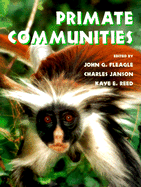Book contents
- Frontmatter
- Contents
- List of contributors
- Preface
- 1 African primate communities: Determinants of structure and threats to survival
- 2 Biomass and use of resources in south and south-east Asian primate communities
- 3 Species coexistence, distribution, and environmental determinants of neotropical primate richness: A community-level zoogeographic analysis
- 4 Primate communities: Madagascar
- 5 Primate diversity
- 6 Phylogenetic and temporal perspectives on primate ecology
- 7 Population density of primates in communities: Differences in community structure
- 8 Body mass, competition and the structure of primate communities
- 9 Convergence and divergence in primate social systems
- 10 Of mice and monkeys: Primates as predictors of mammal community richness
- 11 Comparing communities
- 12 Large-scale patterns of species richness and species range size in anthropoid primates
- 13 The recent evolutionary past of primate communities: Likely environmental impacts during the past three millennia
- 14 Resources and primate community structure
- 15 Effects of subsistence hunting and forest types on the structure of Amazonian primate communities
- 16 Spatial and temporal scales in primate community structure
- 17 Primate communities in Africa: The consequences of long-term evolution or the artifact of recent hunting?
- 18 The future of primate communities: A reflection of the present?
- 19 Concluding remarks
- Systematic index
- Subject index
11 - Comparing communities
Published online by Cambridge University Press: 21 August 2009
- Frontmatter
- Contents
- List of contributors
- Preface
- 1 African primate communities: Determinants of structure and threats to survival
- 2 Biomass and use of resources in south and south-east Asian primate communities
- 3 Species coexistence, distribution, and environmental determinants of neotropical primate richness: A community-level zoogeographic analysis
- 4 Primate communities: Madagascar
- 5 Primate diversity
- 6 Phylogenetic and temporal perspectives on primate ecology
- 7 Population density of primates in communities: Differences in community structure
- 8 Body mass, competition and the structure of primate communities
- 9 Convergence and divergence in primate social systems
- 10 Of mice and monkeys: Primates as predictors of mammal community richness
- 11 Comparing communities
- 12 Large-scale patterns of species richness and species range size in anthropoid primates
- 13 The recent evolutionary past of primate communities: Likely environmental impacts during the past three millennia
- 14 Resources and primate community structure
- 15 Effects of subsistence hunting and forest types on the structure of Amazonian primate communities
- 16 Spatial and temporal scales in primate community structure
- 17 Primate communities in Africa: The consequences of long-term evolution or the artifact of recent hunting?
- 18 The future of primate communities: A reflection of the present?
- 19 Concluding remarks
- Systematic index
- Subject index
Summary
Following upon the chapters in the first section of this volume, which provided geographically restricted overviews of a single biogeographical region, the chapters in this section have provided broad comparisons between the primates of different regions. Fleagle & Reed (chapter 6) review the fossil record of primate evolution over the past 60 million years and examine the relationship between quantitative measures of ecological distance and phylogenetic divergence times within and between communities in the four major geographical regions. Their results indicate that the rate of ecological divergence between pairs of taxa is constant for primates of all regions, but that the strength of the correlation varies depending upon the biogeographical history of the region. They find a major distinction between the extant faunas of Africa and Asia, which contain elements from many different radiations from the past 60 million years and show a high correlation between divergence time and ecological distance, and the faunas of South America and Madagascar that are the result of more temporally restricted explosive radiations.
In contrast to most of the chapters in this volume which compare communities in terms of the component species, Reed's chapter 7 compares modern communities in the four geographical areas from the perspective of how much primate biomass is supported by different types of resources. Comparing the body masses of primates in different regions, she finds Asian communities stand out in having a very restricted size range compared with primates of the other regions.
Ganzhorn (chapter 8) compares patterns of body mass among the primate communities of different biogeographical regions to examine the extent to which there is evidence for competition among primate species within communities.
- Type
- Chapter
- Information
- Primate Communities , pp. 189 - 190Publisher: Cambridge University PressPrint publication year: 1999



